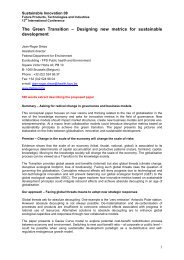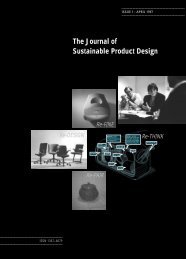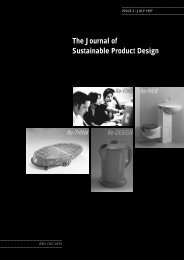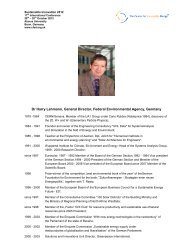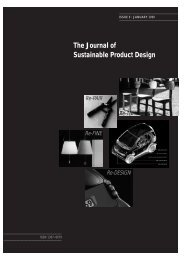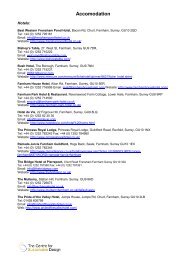Country report on the Indian electronics sector - The Centre for ...
Country report on the Indian electronics sector - The Centre for ...
Country report on the Indian electronics sector - The Centre for ...
You also want an ePaper? Increase the reach of your titles
YUMPU automatically turns print PDFs into web optimized ePapers that Google loves.
<strong>Indian</strong> producti<strong>on</strong> subject to global competiti<strong>on</strong><br />
In<strong>for</strong>mati<strong>on</strong> technology (IT) manufacturing is <strong>the</strong> first industry<br />
<strong>sector</strong> in India to face a zero customs tariff regime. Between<br />
65–70% of <strong>the</strong> products are covered by ITA (In<strong>for</strong>mati<strong>on</strong><br />
Technology Agreement) of <strong>the</strong> World Trade Organisati<strong>on</strong><br />
(WTO) with zero customs tariffs. <strong>The</strong> list of products slated<br />
<strong>for</strong> nil protecti<strong>on</strong> is gradually <strong>on</strong> <strong>the</strong> rise with FTAs (Free Trade<br />
Agreement) becoming part of several bilateral and regi<strong>on</strong>al trade<br />
pacts. Peak tariff levels <strong>for</strong> o<strong>the</strong>r remaining products (especially<br />
c<strong>on</strong>sumer electr<strong>on</strong>ics) were brought down to 12.5% in <strong>the</strong><br />
2006–07 Uni<strong>on</strong> Budget of <strong>the</strong> government. Against a total<br />
global electr<strong>on</strong>ics and IT hardware producti<strong>on</strong> of about $1.4<br />
trilli<strong>on</strong>, India c<strong>on</strong>tributes just over $12 billi<strong>on</strong>.<br />
Since March 2005, over 800 products covering 217 tariff lines<br />
are being imported duty free with <strong>the</strong> first phase of World<br />
Trade Organisati<strong>on</strong>s (WTO) In<strong>for</strong>mati<strong>on</strong> Technology Agreement<br />
(ITA-1) coming into full <strong>for</strong>ce. It is anticipated that very so<strong>on</strong>,<br />
almost every IT and electr<strong>on</strong>ic product manufacturer in India<br />
will have no tariff protecti<strong>on</strong> and will need to compete with<br />
overseas manufacturers. Products that will no l<strong>on</strong>ger enjoy<br />
tariff protecti<strong>on</strong> range from telecom, pers<strong>on</strong>al computers<br />
(PCs), networking, strategic defence, industrial as well as some<br />
c<strong>on</strong>sumer electr<strong>on</strong>ic equipment.<br />
Industry structure, market dynamics and <strong>the</strong><br />
emerging scenario<br />
At present <strong>the</strong>re are more than 3500 manufacturing units of<br />
all sizes directly related to electr<strong>on</strong>ics value chain (employing<br />
10 pers<strong>on</strong>s or more) and assorted clusters of manufacturers<br />
covering nearly 250,000 small and tiny units spread across <strong>the</strong><br />
country which are directly or indirectly related to electr<strong>on</strong>ics and<br />
electrical manufacturing industry. <strong>The</strong>se units employ over 3.5<br />
milli<strong>on</strong> people and if we include pers<strong>on</strong>s indirectly supporting<br />
IT and electr<strong>on</strong>ics manufacturers by providing logistics, post<br />
sales, maintenance and related support services, this number<br />
increases by fur<strong>the</strong>r 2.5 milli<strong>on</strong>. <strong>The</strong> emerging scenario of<br />
technology trends and c<strong>on</strong>sumpti<strong>on</strong> clearly suggest that <strong>the</strong><br />
share of IT and electr<strong>on</strong>ics in India’s output and employment<br />
is likely to go up significantly, subject to this industry finding a<br />
place in <strong>the</strong> global manufacturing value chain. This will bolster<br />
<strong>the</strong> growth of India’s software, ITeS (IT Enabled Services),<br />
defence preparedness and o<strong>the</strong>r emerging industries like<br />
automobiles, precisi<strong>on</strong> engineering as well as biotechnology,<br />
which are now increasingly being driven by IT applicati<strong>on</strong>s. At<br />
present, <strong>the</strong> asymmetry between hardware and software growth<br />
is clear. How <strong>the</strong> IT hardware industry combats <strong>the</strong> challenges<br />
of global competiti<strong>on</strong> will have a bearing <strong>on</strong> future policies<br />
and strategies <strong>for</strong> <strong>the</strong> manufacturing <strong>sector</strong> and <strong>the</strong> growth<br />
trajectory of <strong>the</strong> <strong>Indian</strong> ec<strong>on</strong>omy.<br />
Industry players are trying to carve out a niche in a market that<br />
has just witnessed unprecedented expansi<strong>on</strong>. Sales of pers<strong>on</strong>al<br />
computers (PCs), mobile ph<strong>on</strong>es, telecom accessories and a<br />
Asia Eco-Design Electr<strong>on</strong>ics (AEDE) · 07<br />
wide range of c<strong>on</strong>sumer products including colour televisi<strong>on</strong>s<br />
(TVs) have been increasing. In <strong>the</strong> telecom <strong>sector</strong>, <strong>the</strong> two<br />
leading companies – BSNL (Bharat Sanchar Nigam Ltd) and<br />
MTNL (Mahanagar Telecom Nigam Ltd) are planning to buy<br />
Rs 90,000 crore (US $20 Billi<strong>on</strong>) worth of equipment. <strong>The</strong> PC<br />
market in India is projected to see a massive boom with an<br />
estimated additi<strong>on</strong> of over 50 milli<strong>on</strong> new PC users by 2010<br />
with <strong>the</strong> future market being driven by low cost players. <strong>The</strong><br />
diverse range of new genre digital products that combine<br />
embedded software, Radio Frequency Identificati<strong>on</strong> (RFID)<br />
technologies and manage data, voice as well as video signals<br />
offer huge manufacturing opportunities. <strong>The</strong> fastest growing<br />
segment is telecom with an estimated capital expenditure<br />
of $ 50 billi<strong>on</strong>. India is set to become <strong>the</strong> world’s sec<strong>on</strong>d<br />
largest mobile telecom market by 2007, when <strong>the</strong> projected<br />
mobile ph<strong>on</strong>e subscribers will increase to 250 milli<strong>on</strong> from <strong>the</strong><br />
present range of just below 100 milli<strong>on</strong>. Investments in hi-tech<br />
manufacturing are gradually increasing and announcements to<br />
set up global-size plants in India also include facilities <strong>for</strong> mobile<br />
ph<strong>on</strong>e handsets and accessories.<br />
Discernible shifts and emerging players with<br />
global operati<strong>on</strong>s<br />
<strong>The</strong>re has also been a pr<strong>on</strong>ounced capital flight from IT<br />
hardware to software and services. India’s pi<strong>on</strong>eering IT and<br />
electr<strong>on</strong>ics companies virtually aband<strong>on</strong>ed operati<strong>on</strong>s in<br />
hardware and shifted resources elsewhere. Unlike <strong>the</strong> Chaebols<br />
of Korea or <strong>the</strong> giant c<strong>on</strong>glomerates of Japan, who shaped <strong>the</strong><br />
evoluti<strong>on</strong> of nati<strong>on</strong>al electr<strong>on</strong>ics <strong>sector</strong>, <strong>Indian</strong> manufacturing<br />
has been almost devoid of large business houses. Instead,<br />
some of <strong>the</strong> existing big names like Wipro, HCL, TVS and <strong>the</strong><br />
Tata’s have engaged in low-key manufacturing of IT products<br />
and shifted focus towards software and services. Expanding<br />
operati<strong>on</strong>s of <strong>the</strong> newly emerging software design and<br />
applicati<strong>on</strong> companies are not yet integrated with hardware,<br />
resulting in a ‘lopsided’ growth of <strong>the</strong> IT industry.<br />
On <strong>the</strong> o<strong>the</strong>r hand, a group of new generati<strong>on</strong> and lesser<br />
known entrepreneurs has moved in to dominate <strong>the</strong> IT and<br />
electr<strong>on</strong>ics hardware area, eg. Videoc<strong>on</strong>, Onida group, Moser<br />
Baer, Celetr<strong>on</strong> (now acquired by Jabil Circuit), Samtel, Tejas<br />
Networks, BPL etc. Recently, some multinati<strong>on</strong>al corporati<strong>on</strong>s<br />
(MNCs) have successfully joined <strong>the</strong> hardware manufacturing<br />
bandwag<strong>on</strong>. While software, services and hardware producti<strong>on</strong><br />
have toge<strong>the</strong>r grown to over $40 billi<strong>on</strong>, substantial resources<br />
are yet to be invested into semic<strong>on</strong>ductors or chip<br />
manufacturing despite some modest government ef<strong>for</strong>t since<br />
<strong>the</strong> 1980s (eg. Semic<strong>on</strong>ductor Complex Ltd., BEL, ECIL, ITI,<br />
etc.) catering <strong>for</strong> defence and communicati<strong>on</strong>s. Thus, after five<br />
decades of IT and electr<strong>on</strong>ics manufacturing in India, <strong>the</strong> road<br />
to <strong>the</strong> future, presents a complex but intriguing story. At <strong>the</strong><br />
same time, <strong>the</strong> recent success stories of a few IT manufacturing<br />
companies (including <strong>the</strong>ir worldwide acquisiti<strong>on</strong>s), offer<br />
strategic less<strong>on</strong>s <strong>for</strong> o<strong>the</strong>rs in <strong>the</strong> industry. Embedded



